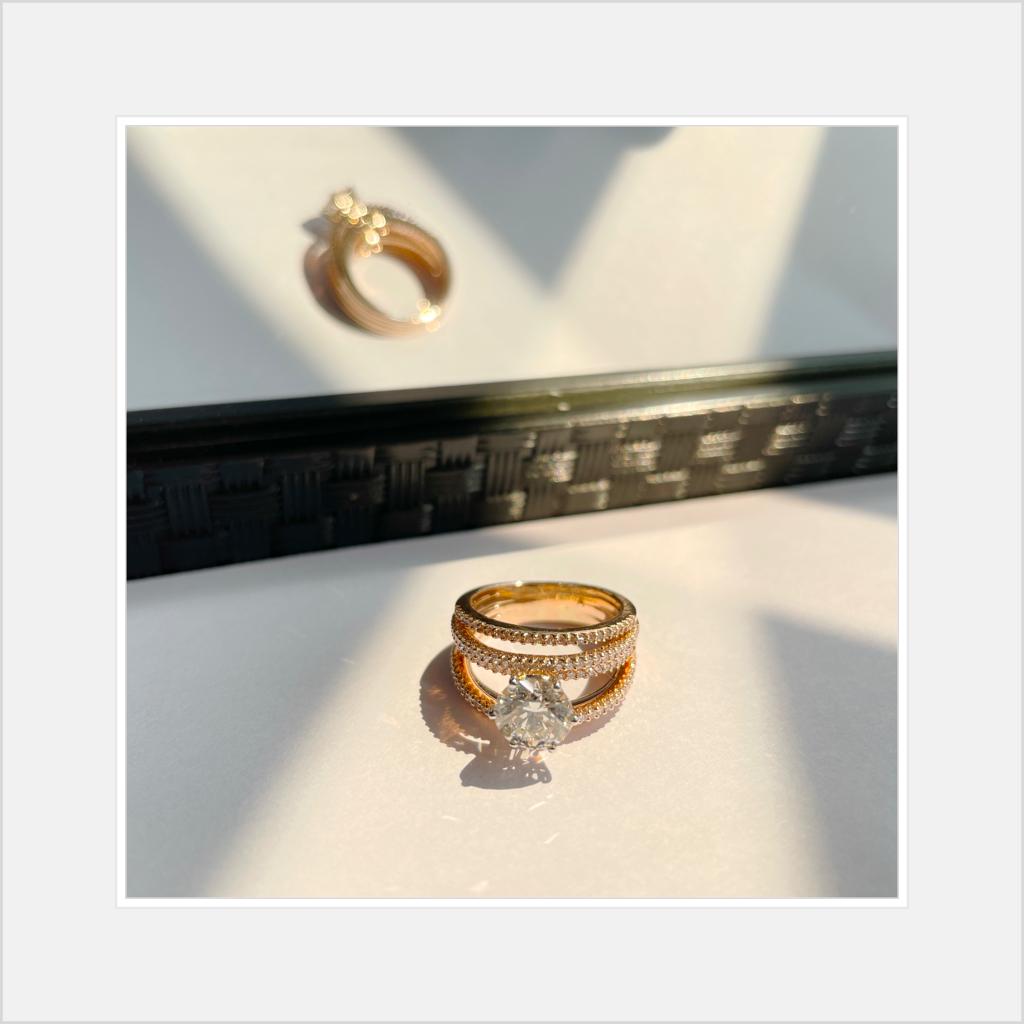Diamond experts weigh in on the growing popularity of lab diamonds
Schenelle Dsouza
You must’ve heard the phrase ‘Diamonds are forever’. A rarity among nature’s many miracles, diamonds are one of the most beautiful items found inside the Earth. However, they do come with a hefty price tag.
Consumers are increasingly becoming aware of the social and environmental cost of retrieving these beautiful gems worth far more than the attached price tag. Apart from extremely dangerous work conditions, uncovering diamonds from the earth does more harm to nature than one can imagine, including a waste of valuable resources and a release of harmful carbons due to diesel fuels used in mining equipment.

Making a shift towards more sustainable methods, jewellery designers and diamond experts have put forth the idea of lab-grown diamonds in the market. Lab-grown diamond jewellery has made a name for itself over the years yet still begs the question: Are lab-grown diamonds even real?
To answer this, LuxeBook spoke to Rohit Pahlajani, Co-Founder, Anantaa Diamonds, Parag Agrawal, Co-Founder & CEO, Fiona Diamonds, Pooja Sheth, Founder and Managing Director, Limelight Diamonds and Ankita Gupta Founder, Syndiora.
Test tube babies
Lab-grown diamonds are 100% real just like naturally mined diamonds. The analogy of a test-tube baby is best to understand the growth of diamonds in a lab. “Lab-grown diamonds are like test-tube babies,” says Ankita Gupta. “In all circumstances, a test-tube baby is the same as a natural-born baby. It lives a normal life just like the latter without any complications. Similarly, lab-grown diamonds are the same as natural mined diamonds.”

Pooja Sheth adds that while the process of making a diamond in a lab is different from naturally mined diamonds, they have the exact same output, just like test-tube babies are the same as naturally born babies.

Rohit Pahlajani further demonstrated that the process of lab-grown diamonds is like building a glacier. “You can make glaciers in your fridge as long as it’s H2O. Similarly, as long as you have carbon with the appropriate atomic structure for a diamond, you can make your own diamond.”
From carbon to crystal
The process of growing a diamond in a lab is surprisingly uncomplicated. Most labs rely on one of two methods either HPHT (High-Pressure High Temperature) or CVD (Chemical Vapour Deposition). Labs in India, however, focus on the method of CVD, where scientists mimic the conditions that lead to the crystallization of carbon.

“The biggest lie told to the consumers is that diamonds take thousands of years to form, which is not true at all,” says Parag Agrawal. “The truth is that diamonds were already formed years ago they are being mined now.”

The process of CVD is simple, which begins by replicating the diamond creation process that occurs below the earth. A mined diamond seed or carbon seed is placed in a chamber that reaches a temperature of about 1500 degrees and 75-80 atmospheres of pressure. This causes the carbon seed to separate and form layers on the mined diamond seed. This slowly grows into a rough lab-grown diamond rock bearing the exact same carbon composition, chemical, thermal and physical properties as a mined diamond.

“Once you create the required conditions you can have your rough diamond anywhere between a few days to few months. The growth capacity for a machine is 50-70 carats a month,” says Pahlajani.
The 4 C’s
After the rough diamond is culminated, it goes through the same processes – cutting, polishing and grinding, before being sent for certification.

“Since lab-grown diamonds are identical to mined diamonds, they have the same 4 C’s– same cut, colour, clarity and carat,” says Sheth.

Agrawal adds, “The diamonds are sent for verification where they are identified based on the cut, colour, clarity and carat. There is a price sheet that determines the price of a diamond based on each of these elements.”
A conflict of interest
Despite the transparency, lab-grown diamonds continue to cause a conflict in the minds of shoppers. There is the reigning mind-set that lab-grown diamonds are synthetic and not real.

“People are conflicted about the concept of lab-grown diamonds,” says Agrawal. “There is no question about the quality of diamonds being different, as they are graded by the International Gemological Institute and the Gemological Institute of America. But people bear the belief that if something isn’t procured naturally from nature, then it is probably artificial.”

However, people have slowly begun opening up to the idea of lab-grown diamonds. “People have become aware about the procedures involved in growing diamonds in a lab,” Gupta adds.
Posing a threat
Diamond mining is one of the most dangerous occupations ever. Each year, more than 15,000 miners are killed due to the hazardous working conditions, and this number is only that of the officially recorded deaths.
Small-scale diamond mining is often conducted without any prior training or expertise. In such situations, miners lack the basic safety equipment among other things without which they can die or be injured in landslides, mine collapses, or other accidents.
Mining diamonds poses one of the biggest threats to the environment. Digging a surface for mining often causes the surrounding land to become contaminated and infertile, apart from the pollution caused. While researching a surface for rough diamonds, miners use two forms of energy, electricity and hydrocarbons, both of which are responsible for abundant carbon emissions like CO2, which contribute to global warming and climate change.

Lab-grown diamonds not only pose one of the safest working conditions but are also 100% better for the earth and the environment.
“Lab-grown diamonds are better for the environment simply because they aren’t mined,” says Gupta. “They aren’t dug out from 150km below the earth thus halting the destruction of land and water associated with mining.”

Today, the world consumes over 100 million carats of mined diamonds, so one can only imagine the damage caused to the earth’s surface, the destruction of land and the gallons of water being wasted in the process. Unlike naturally mined diamonds, a 1 carat lab-grown diamond can save up to 250 tonnes of land and 109 gallons of water.
“Lab-grown diamonds are a great way to invest in diamonds, where the consumer cares for the planet and its people without compromising on quality,” says Sheth.
Growing awareness
Consumers are now becoming educated about non-mined diamonds, how they are grown in labs but remain 100% real. The unique and independent personality of lab-grown diamonds as a sustainable and environmentally friendly, yet extremely affordable gemstone is well-accepted by millennial consumers and is increasingly reflected in the sales of lab-grown diamond jewellery across India.

Millennials form most of the population shifting towards lab-grown diamonds. Today sustainability is a norm. As people become conscious about the earth and environment, the switch to lab-diamonds seems like the most natural decision for them.
The second wave of COVID has played a huge role in promoting lab-grown diamonds in India. The trend of “revenge shopping” led to consumers indulging in luxury purchases as disposable incomes increased for some.

Despite this, the consumer remains extremely price-conscious and looks for value-for-money across all shopping segments. As a result, more and more consumers are now opting for lab-grown diamonds given they are the same but half the price only because they save up on the mining costs.
“We have seen an increase in the demand for lab-grown diamonds. There has been a tremendous hike in sales with 60% growth in revenue,” says Sheth.
Price point
Moving aside all the transparency of lab diamonds, one factor that still conflicts people is the supremely affordable price tag. While lab-grown diamonds are identical to natural mined diamonds, they are merely half the price.
Lab-grown diamonds are cheaper for several reasons. One of them being the elimination of the cost of mining.

“Mining diamonds is labour intensive; the manpower cost is huge, and the facilities have someone sent to mine the diamonds. Whereas diamonds created in labs require more aid from machines than from people,” says Gupta.
Pahlajani adds that mining is an expensive operation. The process of mining diamonds from the earth demands a lot of money and labour. Years of prospecting, and then employing people to work the mine, along with support and other technical setups to keep them safe adds to the cost. Even after the diamond is mined, a lot of money is spent to have them transferred from remote areas for processing. There is also the transportation and insurance costs making it an expensive ordeal.
Lab-grown diamonds on the other hand are a much more affordable process. And so, the price plays an important role in promoting them.




